Abstract
This paper presents a low-noise and low-power audio preamplifier. The proposed low-noise preamplifier employs a delay-time chopper stabilization (CHS) technique and a negative-R circuit, both in the auxiliary amplifier to cancel the non-idealities of the main amplifier. The proposed technique makes it possible to mitigate the preamplifier 1/f noise and thermal noise and improve its linearity. The low-noise preamplifier is implemented in 65 nm complementary metal-oxide semiconductor (CMOS) technology. The supply voltage is 1.2 V, while the power consumption is 159 µW, and the core area is 192 µm2. The proposed circuit of the preamplifier was fabricated and measured. From the measurement results over a signal bandwidth of 20 kHz, it achieves a signal-to-noise ratio (SNR) of 80 dB, an equivalent-input referred noise of 5 nV/√Hz and a noise efficiency factor (NEF) of 1.9 within the frequency range from 1 Hz to 20 kHz.
1. Introduction
The Internet of Things (IoT) is now recognized by the industry, and in particular the electronics industry, as one of the main engines of growth for the decade to come, if not longer. The IoT refers to any application taking advantage of the networking of objects capable of interacting with their environment to measure key parameters of this environment, transmitting this data for analysis, sometimes in real time, and making decisions to control or optimize a system. Detection is the starting point for the IoT and smart home applications. It is also the first problem faced by maker followers and professional designers. The design of many economical transducers such as accelerometers, force sensors, extensometers and pressure transducers is based on resistive Wheatstone bridges for differential voltages in millivolts (mV). Before going into detail, it is essential to accurately capture these low-level signals and amplify them to levels compatible with analog-to-digital converters (ADCs), without DC offset or noise. Likewise, current detection using high potential ammeter shunts requires amplifiers without inputs referenced to ground, and capable of tolerating high common mode voltages. Micro-Electro-Mechanical Systems (MEMS) are sensors or actuators whose lateral dimensions and thickness are of the order of a micrometer. For decades, and still today, MEMS sensors have been manufactured on a large scale for many consumer applications, such as aerospace [1]; inertial sensors in mobile phones, such as gyrometers and accelerometers [2,3]; video game controllers; and airbag triggers. These devices, which are the basis of research tools [4], have reached a sufficient maturity to be directly developed and integrated by large industrial groups, such as STMicroelectronics [5].
In the world of transistors, it is known that the reduction of dimensions mainly makes it possible to integrate more devices on a given surface. Therefore, it enables a reduction of the manufacturing cost of the transistor, to increase the performance of the integrated circuit and to reduce the operating voltage. Regarding sensors, reduced dimensions are other benefits that enabled the development of emerging applications. Therefore, since the 2000s, these sensors are reduced to the nanometer scale with the name “Nano-Electro-Mechanical Systems” (NEMS). These devices allow the study and detection of objects at the molecular scale [6,7] and also at the quantum scale [8]. The constant times are likewise reduced, which implies a limited response time, only because of the electronics control and not the NEMS itself. In addition, in the nanoscale era, we can see a modification in the intrinsic properties of materials as in silicon nanowires, and their thermal and conductive properties modified by the size effect. Hearing implants are technological devices developed to correct hearing loss. Today, the cochlear implant is the most complete system. It implements the fields of acoustics, electronics, signal processing and information, biology, and knowledge of the human physiology. The objective of the microphone is to transduce acoustic waves to an electrical signal. Consequently, it operates in the frequency range from 20 Hz to 20 kHz [9]. The low noise amplifier (LNA) is one of the key devices of an audio system. Located just after the audio sensor, the LNA receives a variety of low-level signals from this sensor. The LNA is placed on top of the audio conditioning chain. Therefore, it must reach a very important signal-to-noise ratio (SNR) output, to facilitate the processing of the audio signal information by the downstream components [10]. The major function of the LNA consists of amplifying the useful signal, while minimizing the noise contribution, and thus allowing the detection of signals at very low powers. Therefore, its linearity, selectivity, lower consumption and reduced surface require a very fine design [11].
There are three types of CMOS dynamic offset cancellation techniques: trimming, chopping, and auto-zeroing [12,13,14]. To eliminate offset during production, trimming technique is usually performed. Chopping involves modulating offset and 1/f noise to a chopping frequency, leaving only white noise in the base band. However, due to the up-modulated offset and 1/f noise, a chopper ripple appears at the amplifier’s output. Auto-zeroing involves sampling the offset and low frequency 1/f noise on an auto-zero capacitor, and then subtracted in subsequent clock phases. However, the noise folding associated with sampling results in increased base band noise [15]. Thus, to achieve high power efficiency, chopping is the technique of choice, provided that associated ripple can be sufficiently suppressed. Chopper amplifiers are widely adopted in these systems for their advantageous low noise, high input impedance, and high common mode rejection ratio (CMRR). Various types of amplifiers for bio-potential measurements have been reported [16,17,18,19,20,21,22,23]. The amplifier reported in [17,18] used a capacitive feedback network and chopper modulation method with a DC servo loop for 1/f noise reduction, but it required a very large capacitor array, which significantly increased its die area [17]. The amplifier reported in [19,20] employed a chopper implemented inside of the feedback loop and thus suffered from CMRR reduction. The instrumentation amplifier reported in [21,22] overcame the CMRR reduction problem with an input impedance boosting loop that added the expense of extra circuitry.
In this paper, we present a high-linear chopper negative-R stabilization audio preamplifier, which employs two proposed techniques to reduce the 1/f noise and the thermal noise at the same time. The two proposed techniques are the delay-time chopper stabilization (CHS) technique [24,25] and the negative-R technique [26]. The paper is organized as follows. Section 2 analyses the delay-time chopper stabilization circuit. Section 3 analyses the chopper negative-R circuit. Section 4 describes the CMOS implementation of the LNA. Section 5 presents the simulation results. Finally, the conclusion is drawn in Section 6.
2. Analysis of the Delay-Time Chopper Stabilization Preamplifier
To reduce the input-equivalent noise of the preamplifier, we propose to use the well-known CHS technique. The CHS preamplifier circuit is shown in Figure 1 [27]. It is composed by the main amplifier, Amain(s), and by the auxiliary amplifier, Aaux(s). The non-idealities of Amain(s) in low-frequency path are canceled by the Aaux(s). Firstly, the input signal at Amain(s) is measured by Aaux(s). Then, the virtual ground VX = VXP − VXN is derived toward zero by Aaux(s). Therefore, a compensation voltage VY = VYP − VYN is generated by the Aaux(s) to the Amain(s). The virtual ground VX can be written as
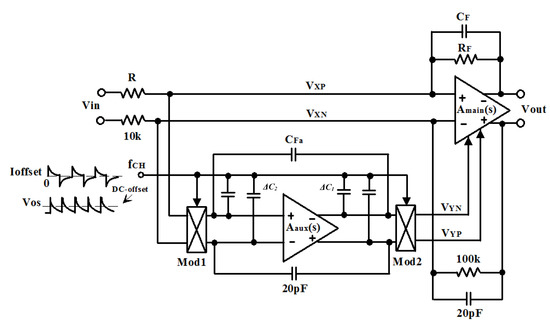
Figure 1.
Chopper stabilization preamplifier.
Namely, the auxiliary amplifier allows attenuating the main amplifier noise portion as
where is the input noise of the main amplifier with the auxiliary amplifier and is the input noise of the main amplifier without the auxiliary amplifier. Aaux_int(s) represents the active RC-integrator signal transfer function (STF), which can be written as
The signal path mismatch and the demodulated current spikes generate a residual offset Vos. Therefore, AC current spike is caused by the mismatch between the capacitances, due to clock feed-through at the chopper clocks transition moments. The first modulator Mod1 rectify this AC current. Therefore, a DC spike current appears at its input. The resulting DC spike current has an average value Ioffset of
where ΔC1 and ΔC2 denote the CHS mismatch parasitic capacitance, Vclk denotes the clock signal magnitude, and fCH denotes the Chopping clock frequency. The chopper series impedance and the input signal source are going through by this noise current. Therefore, it depicts as an input voltage spike. The residual offset Vos resulting from the spike average DC value can be written as
where R denotes the equivalent input impedance. Therefore, a residual offset Vos depicts the spike average DC value. Moreover, a spike voltage Vos is created in the input of the Mod1. This spike voltage causes a low-frequency interference.
To cancel out this interference, we propose to create a proper delay Δt between Mod1 and Mod2. The proposed preamplifier CHS technique is shown in Figure 2. The auxiliary amplifier is located between two modulating clock signals: m1(t) and m2(t) with period T. Moreover, we introduce a delay ∆t between the two clock signals m1(t) and m2(t) at the same time. Due to the introduction of the delay ∆t, this technique causes a chopping of the spike signal itself. Therefore, the DC content of the output signal Vout(t) is minimized. The residual output DC offset is completely cancelled if an optimum delay value ∆topt exists, which can be written as
where τ = R × Cin with R, and Cin denotes respectively the input resistance and the amplifier’s input capacitance.
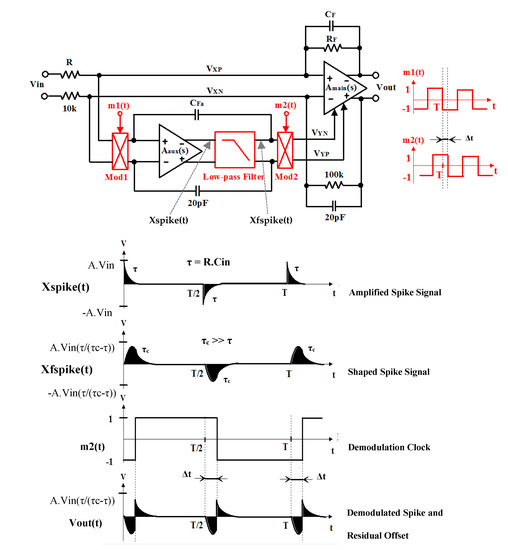
Figure 2.
Delay-time chopper stabilization preamplifier.
The major weakness of this technique is the τ itself, which not only depends on the amplifier’s source resistance R, but also on its input capacitance Cin. The input preamplifier’s spike signal is amplified and then multiplied with m2(t). The resulting output signal VY then contains, apart from higher order harmonics of the chopping frequency, a DC part or residual offset, which is due to chopping artifacts. To solve this problem, shaping of the spike can be introduced by the addition of a first order low-pass filter with time constant τc after Aaux(s). We must have T >> τc >> τ with T is the period of the square wave signal m1(t). The shape of the time response of the filtered spike is primarily determined by τc. Since the output offset is still linearly dependent on τ, the optimization of ∆topt has been done in such a way that offset reduction is most effective for a worst-case preamplifier resistance. For our specific implementation ∆topt/τc = 0.8 has been chosen. The low-pass filter has a cut-off frequency of 300 kHz. The nominal chopping frequency fCH is 120 kHz.
3. Analysis of the Chopper Negative-R Stabilization Preamplifier
The delay-time chopper stabilization removes only the 1/f noise of the preamplifier. However, the chopper does not affect the Aaux(s) thermal noise, and the overall noise level of the preamplifier is not reduced. Likewise, a large bandwidth of Aaux(s) is required in order to keep its high gain at fCH. To reduce both the 1/f noise and the thermal noise, we propose to use the chopper negative-R stabilization circuit as shown in Figure 3. This proposed technique allows removing the preamplifier non-ideality at VX. It will compensate for the error current IR and IRF generated by R and RF, respectively at VX. Therefore, we choose the negative-R value in order to matching the value of the parallel resistors R//RF. As a result, the chopper negative-R stabilization technique allows mitigating the VX error. In the first case, the preamplifier noise is analyzed without the negative-R circuit. The overall main and auxiliary opamps noise transfer function (NTF) can be written as
where denotes the input-referred noise of preamplifier, and denotes the noise of opamps. The noise are calculated at the preamplifier input node. In the second case, the preamplifier noise is analyzed with the chopper negative-R circuit. The overall main and auxiliary opamps NTF becomes
where the very important coefficient α denotes the negative-R matching coefficient of the parallel resistors R//RF. If α becomes closer to 2, ideal compensation for α = 1, the noise opamps decreases.
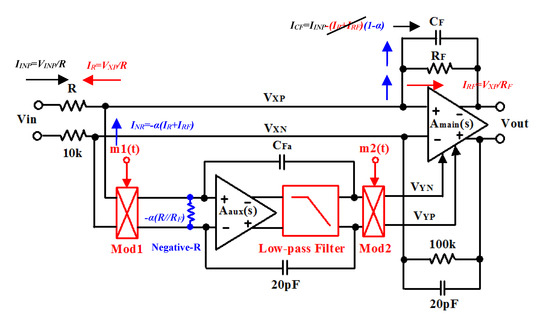
Figure 3.
Chopper negative-R stabilization preamplifier.
However, the negative-R circuit adds an amount of noise of , with in this case. As a result, the proposed negative-R preamplifier has an input-referred noise of
where |H(s)|2 denotes the NTF of the negative-R opamps of Equation (8). Therefore, the chopper negative-R circuit allows attenuating the opamps mismatch and offset.
4. CMOS Amplifier Implementation
If the amplifier is designed with a single-stage topology under low-voltage operation, then its output swing and its gain are limited. Usually, an amplifier with a two-stage topology, as shown in Figure 4, is used to increase the gain and the output swing. The first stage of the amplifier contributes to the total gain while the second stage contributes to enable a large output swing. The compensation capacitor (CS) allows stabilizing the two-stage amplifier. In order to improve the frequency response, a resistor is connected in series with the capacitor CS. Therefore, the amplifier receives a left half plane zero [28].
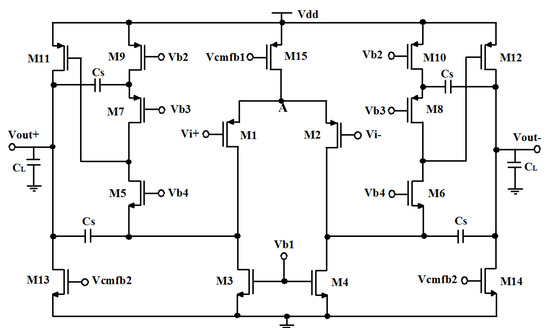
Figure 4.
Folded-cascode operational transconductance amplifier (OTA) circuit.
A desired gain-bandwidth (GBW) and a load capacitance (CL) are considered to evaluate the amplifier power consumption. If all amplifier transistors have the same overdrive voltage , and if the output non-dominant pole is at least three times of the GBW, then the current consumption Itwo-stage of the two-stage operational transconductance amplifier (OTA) can be written as [29,30].
From Equation (10), it is clear that the maximum of the current is used to drive the compensation capacitors.
Figure 4 shows the schematic of two-stage amplifier. The first stage is a differential OTA providing high gain, while the second stage is configured as a simple common-source stage to give maximum output swing. In contrast to cascode opamps, this topology isolates the gain and output swing requirements [29,30]. The DC-gain Ad and GBW expressions of the amplifier is given as
where gm1 and gm3 denote the transconductance of transistor M1 and M3, r01, r02, r03, and r011 denote the output resistance of transistors M1, M2, M3, and M11, respectively. Assuming all the transistors have the same overdrive voltage, the transconductance gm of M1 and M3 can be written as
where ID denotes the drain current, VT denotes the threshold voltage, and VGS denotes the gate-source voltage of the MOSFET. Further, assuming all branches have the same current and ignoring parasitic capacitance at node A, Equation (12) can be modified as
where λ denotes the channel-length modulation parameter of the MOSFET. Combining Equations (13)–(15), the total current of the two-stage OTA is then
Since the parasitic capacitor at node A is negligible, for more power saving, the frequency compensation is performed by the load capacitance, and no miller compensation is used. The maximum output swing that this amplifier can achieve is . To achieve a higher signal swing, the overdrive voltage of transistors M4 and M5 are minimized in this design. The two-stage OTA has an open-loop gain of 65-dB, a phase margin of 62°, and a GBW of 16-MHz, with a power consumption of only 72-μW.
The noise sources of the CMOS operational amplifier originate from flicker noise and thermal noise components. The flicker noise component is usually larger than the thermal noise component for frequencies from 1 Hz to 20 kHz for a typical bias conditions and device geometries. The total noise current of a MOSFET is given as [30]
Neglecting the thermal noise contribution, the total noise current can be approximated as:
with:
where KF is the flicker noise coefficient, gm is the transconductance parameter of the MOSFET device, COX is the gate-oxide capacitance per unit area, W is the channel width, L is the channel length, f is the frequency, m represents the effective mobility, ID is the drain current, and Δf is the bandwidth. Thus, the equivalent input-referred voltage noise can be written as:
Noise analysis of the two-stage operational amplifier of Figure 4 yields
where denotes the thermal noise of transistor M1, and denotes the thermal noise of transistor M3. Substituting Equations (19) and (20) into Equation (21), we have
where the symbols have their usual meanings, and the subscript n represents n-channel device, and subscript p represents p-channel device. It is apparent from Equation (22) that there exists a minimum as L1 varies. For very low values of L1, the first term is dominant, whereas for large L1 values, the second term is dominant. Although the low-noise design practice adapts long channel length L3 for active load and short channel length L1 for good phase margin.
The transistor-level circuit of the negative-R is shown in Figure 5. It is implemented in a topology of MOSFET source-degeneration. It consumes only 12-μW. In this topology, the degeneration resistor and the current source allows enhancing the accuracy of matching the circuit within 10%. Moreover, a stable gm of the negative-R is maintained over the temperature and power supply variations [26].
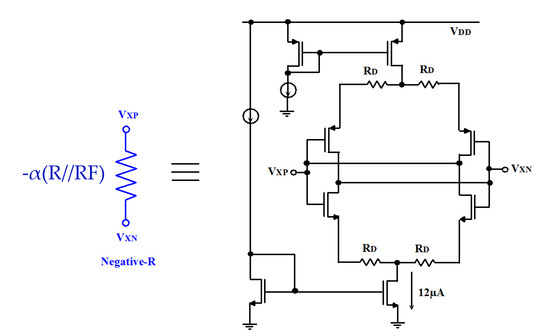
Figure 5.
Negative-R circuit.
5. Measurement Results
Prototypes of the low-noise preamplifier are fabricated and experimentally characterized. The die microphotograph of the preamplifier is shown in Figure 6. The measurement result of the preamplifier input-referred noise with CHS circuit and with chopper negative-R circuit is shown in Figure 7. The preamplifier has a bandwidth of 20 kHz. From measurement result, if the preamplifier is with CHS circuit, then its input-referred noise is 11 nV/√Hz. If the preamplifier is with chopper negative-R circuit, then its input-referred noise is almost limited by the R, RF, and negative-R thermal noise and it is attenuated to 5 nV/√Hz. Moreover, it is clear from measurement result that the chopper negative-R circuit allows to mitigate the opamps 1/f noise and thermal noise. As a result, the proposed chopper negative-R stabilization preamplifier allows a noise reduction of 2.2 times, compared to the conventional preamplifier. The curves in Figure 8 show the SNR of the preamplifier as a function of the power consumption. Simulation results have been added for comparison. It appears that the evolution of the experimentally measured SNR is consistent with that obtained with the simulation results. The maximum measured SNR is 80 dB. This value is nearly the same as the simulation result. It is obtained for a current of 132 μA. It corresponds to a power consumption of 159 µW.
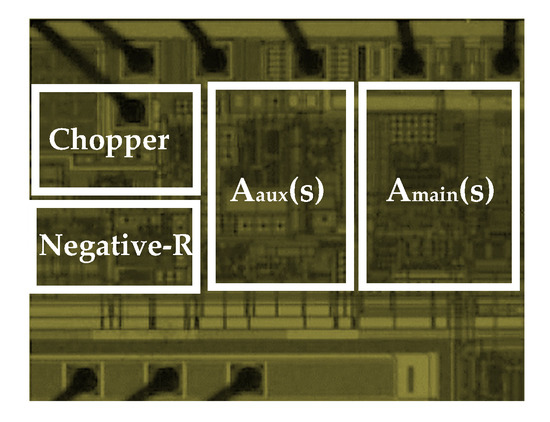
Figure 6.
Chip microphotograph of the proposed chopper negative-R stabilization preamplifier in 65 nm CMOS process with an area of 192 µm2.
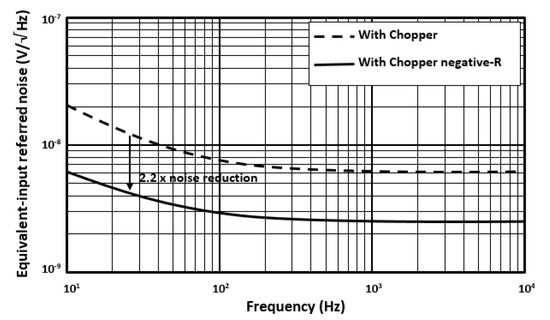
Figure 7.
Equivalent-input referred noise of the proposed chopper negative-R stabilization preamplifier.
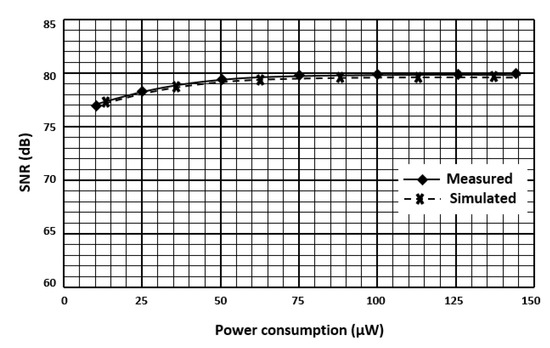
Figure 8.
Signal-to-noise ratio (SNR) of the proposed chopper negative-R stabilization preamplifier versus power consumption.
The measurement results of the proposed low-noise preamplifier and the comparison with other amplifiers is reported in Table 1. A fundamental parameter is used to evaluate the overall power efficiency of the preamplifier. This parameter is the noise efficiency factor parameter (NEF), which can be written as [31]
where Itotal is the total current consumption, Vrms is the root-mean square (RMS) input-referred noise, Uth is the thermal voltage, and BW is the bandwidth of the preamplifier. From Equation (23), it is clear that the NEF parameter includes almost every performance shown in Table 1, namely the equivalent-input referred noise, the power consumption, the bandwidth and indirectly the power-supply rejection ratio (PSRR), and the common-mode rejection ratio (CMRR). In [32,33], the preamplifier has a high CMRR and high PSRR. However, it has also a high equivalent-input referred noise at list of about 18 nV/√Hz. In [22,23], the measured preamplifier has a low CMRR and low PSRR. Moreover, it has a worse equivalent-input referred noise at least 47 nV/√Hz. Therefore, this noise level affects drastically the preamplifier and degrades its performances. As a result, all compared preamplifiers have an equivalent-input referred noise greater than 18 nV/√Hz. On the other hand, our measured preamplifier has a high CMRR and high PSRR. Moreover, it has the lowest equivalent-input referred noise of only 5 nV/√vHz. As a result, for the same performances, our preamplifier has a good tradeoff between the supply voltage, the PSRR, and the CMRR. Our proposed circuit achieves a NEF of 1.9, a PSRR of 110 dB and a CMRR of 121 dB. Therefore, it proves a competitive performance compared to the state-of-the art.

Table 1.
Performances Comparison of the Proposed Preamplifier with the State-of-the Art.
6. Conclusions
Two proposed techniques to reduce 1/f noise, thermal noise and power consumption of an audio preamplifier are presented in this paper. The preamplifier includes a chopper negative-R stabilization preamplifier, which employs a delay-time chopper stabilization and a negative-R circuit both in the auxiliary amplifier path to cancel the non-idealities of the main amplifier. The low-noise preamplifier is implemented in a 65 nm CMOS technology. The supply voltage is 1.2 V while the power consumption is 159 µW and the core area is 192 µm2. The low-noise preamplifier was fabricated and measured. From measurement results over a signal bandwidth of 20 kHz, the proposed preamplifier achieves an SNR of 80 dB, and an equivalent input-referred noise of 5 nV/√Hz. The proposed chopper negative-R stabilization technique mitigates the requirements including thermal noise, 1/f noise, and linearity, thus reducing the power dissipation of the preamplifier.
Author Contributions
Conceptualization, J.N. and K.A.; methodology, J.N.; validation, J.N., K.A. and S.M.; formal analysis, J.N.; investigation, K.A.; resources, S.M.; writing—original draft preparation, J.N.; writing—review and editing, J.N.; supervision, J.N.; All authors have read and agreed to the published version of the manuscript.
Funding
This research received no external funding.
Acknowledgments
This project was supported by the Deanship of Scientific Research at Prince Sattam Bin Abdulaziz University under the research project 2017/01/6899.
Conflicts of Interest
The authors declare no conflict of interest.
References
- Barbour, N.; Hopkins, R.; Kourepenis, A.; Ward, P. Inertials MEMS systems and applications. Lect. NATO Sci. Technol. Organ. 2011, 116, 1–18. [Google Scholar]
- Yazdi, N.; Ayazi, F.; Najafi, K. Micromachined inertial sensors. Proc. IEEE 1998, 86, 1640–1659. [Google Scholar] [CrossRef]
- Bell, D.J.; Lu, T.J.; Fleck, N.A.; Spearing, S.M. MEMS actuators and sensors: Observation on their performance and selection for purpose. J. Micromech. Microeng. 2005, 15, 153–164. [Google Scholar] [CrossRef]
- Duraffourg, L.; Laurent, L.; Moulet, J.; Arcamone, J.; Yon, J. Array of Resonant Electromechanical Nanosystems: A Technological Breakthrough for Uncooled Infrared Imaging. Micromachines 2018, 9, 401. [Google Scholar] [CrossRef]
- Yole Developpement. Technology Trends for Inertial MEMS; Cision PR Newswire: New York, NY, USA, 2012; pp. 1–12. [Google Scholar]
- Li, M.; Tang, H.X.; Roukes, M.L. Ultra-sensitive NEMS-based cantilevers for sensing, scanned probe and very high frequency applications. Nat. Nanotechnol. 2007, 2, 114–120. [Google Scholar] [CrossRef]
- Naik, A.K.; Hanay, M.S.; Hiebert, W.K.; Feng, X.L.; Roukes, M.L. Towards single-molecule nanomechanical mass spectrometry. Nat. Nanotechnol. 2009, 4, 445–450. [Google Scholar] [CrossRef]
- Keith, S.C.; Roukes, C.L. Putting mechanics into quantum mechanics. Phys. Today 2005, 58, 36–42. [Google Scholar]
- Kitchin, C.; Counts, L. A Designer’s Guide to Instrumentation Amplifiers; Analog Devices: Norwood, MA, USA, 2006. [Google Scholar]
- Mehta, N.; Huijsing, J.H.; Stojanovic, V. A 1-mW Class-AB Amplifier with -101 dB THD+N for High Fidelity 16 Ω Headphones in 65-nm CMOS. IEEE J. Solid State Circuits 2019, 54, 948–958. [Google Scholar] [CrossRef]
- Lee, J.; Lee, K.R.; Ha, U.; Kim, J.H.; Lee, K.; Gweon, S.; Jang, J.; Yoo, H.J. A 0.8-V 82.9-μ W In-Ear BCI Controller IC with 8.8 PEF EEG Instrumentation Amplifier and Wireless BAN Transceiver. IEEE J. Solid State Circuits 2019, 54, 1185–1195. [Google Scholar] [CrossRef]
- Michiel, A.P.; Pertijs, M.; Kindt, W.J. A 140-dB CMRR current-feedback instrumentation amplifier employing ping-pong auto-zeroing and chopping. IEEE J. Solid State Circuits 2010, 45, 2044–2056. [Google Scholar]
- Wu, J.; Law, M.K.; Martins, R.P. A 2-lW 45-nV/HHz readout front end with multiple-chopping active-high-pass ripple reduction loop and pseudo-feedback DC servo loop. IEEE Trans. Circuits Syst. II 2016, 63, 351–355. [Google Scholar] [CrossRef]
- Wu, R.; Huijsing, J.H.; Makinwa, K.A.A. A chopper current-feedback instrumentation amplifier with a 1 mHz 1/f noise corner and an AC-coupled ripple-reduction loop. IEEE J. Solid State Circuits 2009, 44, 3232–3243. [Google Scholar] [CrossRef]
- Enz, C.C.; Temes, G.C. Circuit techniques for reducing the effects of op-amp imperfections: Autozeroing, correlated double sampling, and chopper stabilization. Proc. IEEE 1996, 84, 1584–1614. [Google Scholar] [CrossRef]
- Luo, D.; Zhang, M.; Wang, Z. A Low-Noise Chopper Amplifier Designed for Multi-Channel Neural Signal Acquisition. IEEE J. Solid State Circuits 2019, 54, 2255–2265. [Google Scholar] [CrossRef]
- Denison, T.; Consoer, K.; Santa, W.; Avestruz, A.T.; Cooley, J.; Kelly, A. A 2 µW 100 nV/√Hz chopper-stabilized instrumentation amplifier for chronic measurement of neural field potentials. IEEE J. Solid State Circuits 2007, 42, 2934–2945. [Google Scholar] [CrossRef]
- Yeager, D.; Zhang, F.; Zarrasvand, A.; George, N.T.; Daniel, T.; Otis, B.P. A 9 µA addressable Gen2 sensor tag for biosignal acquisition. IEEE J. Solid State Circuits 2010, 45, 2198–2209. [Google Scholar] [CrossRef]
- Verma, N.; Shoeb, A.; Bohorquez, J.; Dawson, J.; Guttag, J.; Chandrakasan, A.P. A micro-power EEG acquisition SoC with integrated feature extraction processor for a chronic seizure detection system. IEEE J. Solid State Circuits 2010, 45, 804–816. [Google Scholar] [CrossRef]
- Abdelhalim, K.; Jafari, H.M.; Kokarovtseva, L.; Velazquez, J.L.P.; Genov, R. 64-channel UWB wireless neural vector analyzer SOC with a closed-loop phase synchrony-triggered neurostimulator. IEEE J. Solid State Circuits 2013, 48, 2494–2510. [Google Scholar] [CrossRef]
- Fan, Q.; Sebastiano, F.; Huijsing, H.; Makinwa, K.A.A. A 1.8 µW 60 nV/√Hz capacitively-coupled chopper instrumentation amplifier in 65 nm CMOS for wireless sensor nodes. IEEE J. Solid State Circuits 2011, 46, 1534–1543. [Google Scholar] [CrossRef]
- Chandrakumar, H.; Markovi¢, D. A high dynamic-range neural recording chopper amplifier for simultaneous neural recording and stimulation. IEEE J. Solid State Circuits 2017, 52, 645–656. [Google Scholar] [CrossRef]
- Zheng, J.; Ki, W.H.; Hu, L.; Tsui, C.Y. Chopper capacitively coupled instrumentation amplifier capable of handling large electrode offset for biopotential recordings. IEEE Trans. Circuits Syst. II Express Briefs 2017, 63, 1392–1396. [Google Scholar] [CrossRef]
- Lee, H.S.; Nguyen, V.N.; Pham, X.L.; Lee, J.W.; Park, H.K. A 250-µW, 18-nV/√Hz current-feedback chopper instrumentation amplifier in 180-nm CMOS for high-performance bio-potential sensing applications. Analog Circuits Signal Process. 2017, 90, 137–148. [Google Scholar] [CrossRef]
- Nebhen, J.; Ferreira, P.M.; Mansouri, S. A chopper stabilization audio instrumentation amplifier for IoT applications. J. Low Power Electron. Appl. 2020, 10, 13. [Google Scholar] [CrossRef]
- Jang, M.; Lee, C.; Chae, Y. Analysis and design of low power continuous-time Delta-Sigma modulator using negative R assisted integrator. IEEE J. Solid State Circuits 2019, 54, 277–287. [Google Scholar] [CrossRef]
- Burt, R.; Zhang, J.A. Micropower chopper-stabilized operational amplifier using a SC notch filter with synchronous integration inside the continuous-time signal path. IEEE J. Solid State Circuits 2006, 41, 2729–2736. [Google Scholar] [CrossRef]
- Gray, P.R.; Meyer, R.G. Analysis and Design of Analog Integrated Circuits, 2nd ed.; Wiley: New York, NY, USA, 1984; pp. 750–752. [Google Scholar]
- Nebhen, J.; Masmoudi, M.; Rahajandraibe, W.; Aguir, K. High DC-gain Two-Stage OTA Using Positive Feedback and Split-Length Transistor Techniques. In Advances in Data Science, Cyber Security and IT Applications. ICC, Communications in Computer and Information Science; Alfaries, A., Mengash, H., Yasar, A., Shakshuki, E., Eds.; Springer: Cham, Switzerland, 2019; Volume 1098. [Google Scholar]
- Nebhen, J.; Savary, E.; Rahajandraibe, W.; Dufaza, C.; Meillere, S.; Kussener, E.; Barthelemy, H.; Czarny, J.; Lhermet, H. Low-noise CMOS amplifier for readout electronic of resistive NEMS audio sensor. In Proceedings of the 2014 Symposium on Design, Test, Integration and Packaging of MEMS/MOEMS (DTIP), Cannes, France, 1–4 April 2014. [Google Scholar]
- Harrison, R.; Charles, C. A low-power low-noise CMOS amplifier for neural recording applications. IEEE J. Solid State Circuits 2003, 38, 958–965. [Google Scholar] [CrossRef]
- Kwon, Y.; Kim, H.; Kim, J.; Han, K.; You, D.; Heo, H.; Cho, D.; Ko, H. Fully Differential Chopper-Stabilized Multipath Current-Feedback Instrumentation Amplifier with R-2R DAC Offset Adjustment for Resistive Bridge Sensors. Appl. Sci. 2019, 10, 63. [Google Scholar] [CrossRef]
- Butti, F.; Piotto, M.; Bruschi, P. A Chopper Instrumentation Amplifier with Input Resistance Boosting by Means of Synchronous Dynamic Element Matching. IEEE Trans. Circuits Syst. I Regul. Pap. 2017, 64, 753–794. [Google Scholar] [CrossRef]
© 2020 by the authors. Licensee MDPI, Basel, Switzerland. This article is an open access article distributed under the terms and conditions of the Creative Commons Attribution (CC BY) license (http://creativecommons.org/licenses/by/4.0/).